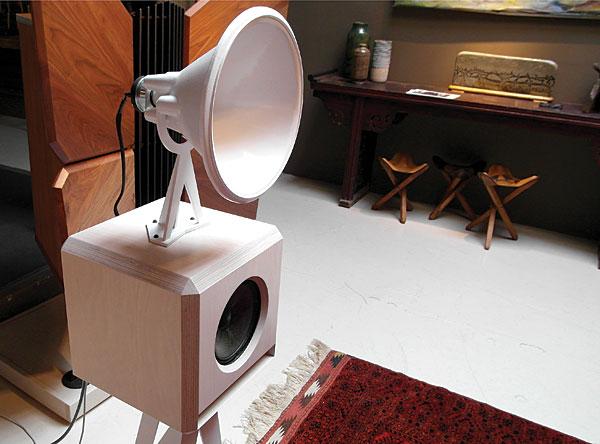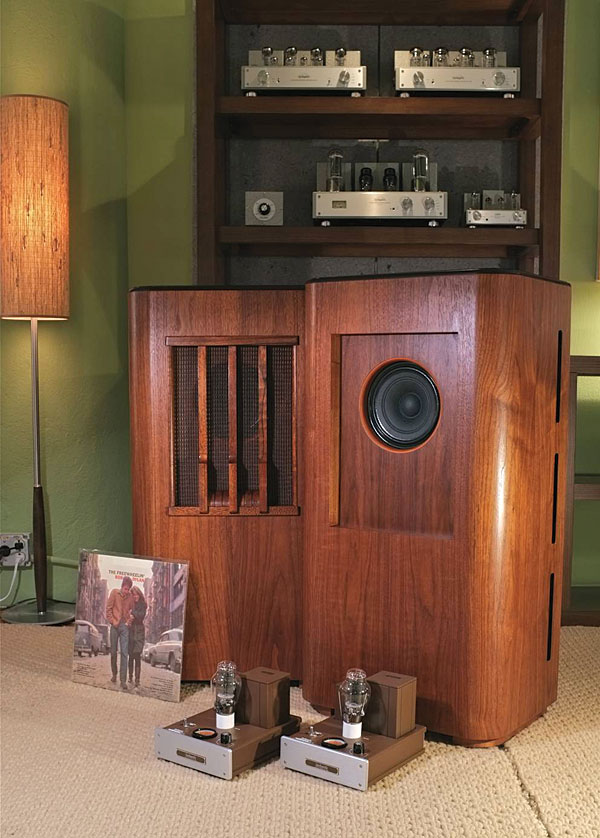| Columns Retired Columns & Blogs |
The cabinetry of those speakers are Beautiful. Nice article Art.

Air-conditioners have improved since 1962. So have automobiles and contact lenses and light bulbs and copiers and television sets. So have lots of other consumer goods.
It's reasonable for the average person to assume that hi-fi gear has also improved over the years, but that isn't entirely true. Although the audio industry has made strides in eliminating tonal distortions and in creating for the listener a more exciting spatial presentation of recorded sound, to me early playback equipment endures in sounding far more tactile, dramatic, and colorful. In those respects, contemporary gear has not only failed to hold its ground since 1962, it has markedly declined.
In other consumer industries, developmental gains appear to come at relatively little cost. In the quest for cars that are safer, faster, and more comfortable, fuel efficiency hasn't merely remained steady: It has improved, along with everything else. Yet audio engineers often seem no better at banishing distortions than I am at shooing flies out of the house: They can't get rid of one without letting in another. Amplifier designers sacrifice immediacy and speed for power, phonograph designers sacrifice musical dynamics for low tracking force, and loudspeaker designers swap efficiency for extended bass and treble.
Think of it: A loudspeaker's most fundamental task is to convert electricity into sound—a task at which the average new model fails more resoundingly with each passing year. What the hell kind of progress is that?
Funny you should ask
The up side of living inside an engineering swap meet: One can choose from a very wide range of commercial products, each with a different combination of strengths. As I noted in last issue's column, all in this hobby are free to prioritize for themselves those characteristics of live music to which the highest playback fidelity should be applied—and some of those aspects are indeed served well by combinations of powerful amplifiers and inefficient loudspeakers. In years past I have been not only impressed but delighted by such things as Stax F-81s driven by a Krell KSA-50, and Magneplanar MG-IIIs paired with a Conrad-Johnson Premier One. Those and other such systems can be considered every bit as good as the sort to which my present tastes have led me: just as faithful, but faithful to different aspects of the art of music.
As I've also pointed out, listeners who assign a greater importance to impact and color in music playback will find much to enjoy in certain vintage loudspeakers. Yet to find, buy, or install those speakers may not be as easy as one might wish. RCA LC1s don't turn up for sale very often. Western Electric 753s are even less likely to appear on the market—and when they do, their prices are horrifying. Altec Flamencos and Valencias weigh nearly 100 lbs each and tend not to fit in many compact cars—or compact rooms.
In this month's column, then, the question switches from Why not vintage? back to Why not new? In response to a growing interest in all things antique, not to mention an enduring shortage of full-range loudspeakers capable of being driven by low-power tube amplifiers, some contemporary manufacturers are bringing to market speakers whose vintage DNA is unmistakable. Five such models spring immediately to mind, two of which I've auditioned at length, another two of which—the DeVore Fidelity Orangutan O/96 and the current-day version of the Klipsch La Scala—are due to arrive here within the next month or two, and one of which remains elusive. The last is the classic Western Electric 753: not the extinct original, of course, but faithful reproductions presently offered by two different companies, with a third on its way. Shindo Laboratory and Déjà Vu Audio both offer custom-built speakers inspired by the original 753—in both instances, price varies with the exact driver complement desired—and Auditorium 23 plans to release one in the near future, as part of their Hommage series.
That brings us to two interesting and very different vintage-vibe speakers of my recent experience:
Oswalds Mill Audio Mini
Knowing that the other three loudspeaker models from Oswalds Mill Audio are built—and priced—on a grand scale, one might expect that the comparatively small and affordable OMA Mini ($18,000/pair) might also be comparatively disappointing: a compromise product for which people with smaller rooms and budgets are forced to settle. Nothing could be further from the truth, and after two visits to OMA's showroom in Brooklyn's Dumbo district—Down Under the Manhattan Bridge Overpass, for you non-New Yorkers—the Mini remains my favorite of their speakers in a number of ways.
OMA's loudspeakers are distinguished by their use of conical horns, cast from aluminum at a foundry near their workshop, in rural Pennsylvania. So it goes with the Mini, in which a proprietary horn-loaded compression driver handles the high and mid-frequencies. The two-way Mini also uses an 8" woofer in a ported enclosure made of the buyer's choice of birch ply or bamboo ply. The cabinet walls are thick, the quality of the joinery just as impressive; the front-firing port runs nearly its entire 14" width. The Mini's carbon-fiber woofer has an impregnated fabric surround and appears rather stiffly suspended; that plus the narrow port—the enclosure seems to split the difference between bass-reflex and aperiodic designs—combine to make what one assumes is an intentionally low-Q system in which smoothness of response and sensitivity (rated at 95dB) are emphasized over bass extension per se.
Listening bore that out. Aesthetically, the Mini's upper-frequency horn stands out from the rest of the speaker, but sonically the opposite was true: OMA's smallest loudspeaker is remarkably coherent. Its crossover, which I'm told is quite simple, is apparently also quite well done.
That quality is complemented by a well-chosen frequency range. The Mini's bass response, specified as 3dB down at 60Hz, is balanced by a treble range that leaves the speaker sounding neither dull nor lightweight. At OMA's Dumbo showroom, a pair of Minis gave fine weight to smaller-scale orchestral music—a 1961 recording of Igor Stravinsky conducting the Columbia Chamber Ensemble in his L'Histoire du Soldat Suite sounded amazingly lifelike—and modern pop alike. Far more important was the generous sense of touch the OMA speakers gave to that and virtually every other recording I tried over the course of two listening sessions there. Plucked strings—never in short supply in Stravinsky—leaped from the system as they should have. (And what are horns for if not for tactile musical thrills such as that?)
The styling of the OMA Mini, by the industrial designer and lighting specialist David D'Imperio, is distinctive: wood grain here, steel legs there, curves, angles, visual weight, and open spaces. One assumes a pair of them would go nicely with contemporary furnishings, yet I've seen proof of how their whimsical modernism jibes with the rich textures of antique furnishings and Oriental rugs. What I haven't seen is how they look in my listening room; as of this writing, review loaners aren't available. But hope springs eternal: I think this is a wonderful speaker that asks prospective owners to take a few chances, and richly rewards them with real-sounding music.
Line Magnetic 755 I
I wrote last month about the famed Western Electric 755a, a full-range drive-unit admired by most vintage-speaker experts of my acquaintance. Now a company called Line Magnetic Audio has begun to manufacture their own version of this classic. Their new 755 EX driver is a faithful reproduction of the 755a in every way but two: Its nominal impedance is 8 instead of 4 ohms, and, instead of a permanent magnet, the Line Magnetic 755 EX uses a field coil—an electromagnet—that's energized by DC from an outboard power supply.

This is no mere affectation, vintage for the sake of vintage: The magnetic flux density of a permanent magnet is known to change in response to vibrational energy and heat—of which moving-coil speakers are reliable producers—whereas a field coil with a very good DC supply can focus a far stiffer, stabler, sturdier energy field on the voice-coil gap, allowing dynamic contrasts in particular to be resolved with far greater efficiency.
This new-old 755, keenly anticipated for years, is available now in a loudspeaker called the Line Magnetic 755 I ($8995/pair), in which two field-coil 755 EX drivers are installed in floorstanding cabinets of original design and bundled with a pair of Line Magnetic PR-3 field-coil power supplies, all made in the People's Republic of China. System sensitivity is specified as 94dB.


I was surprised to see these cabinets. Have a look at these, which my father imported from the Utopia Instrument Company (Japan) more than 20 years ago:
http://www.utopianet.co.jp/product/enclosure/21_03.html
The were inspired by this original Jensen design:
http://www.utopianet.co.jp/product/enclosure/21_02.html
The venting system was developed by Mr. Maekawa, the president and designer at Utopia. I am not sure if Line Magnetics is contracting with Utopia to make these cabinets for them or if these are a copy, but I thought someone might be interested in seeing the lineage.

Line Magnetic has now developed an EXACT replica of the WE755 using an Alnico magnet like the original. It is being used in Auditorium 23's new Hommage Ken speaker. My wife and I spend two days auditioning the Ken at Don Better Audio. It is wonderful. We gave in and have a pair on order.